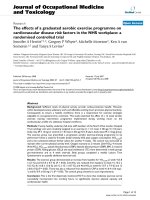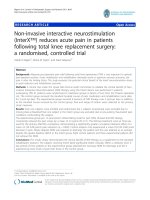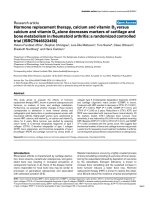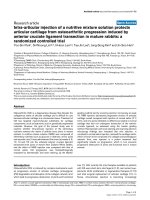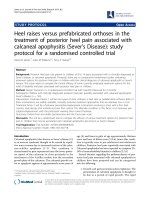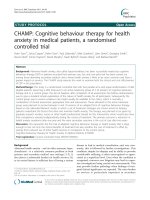Oral misoprostol in preventing postpartum haemorrhage in resource-poor communities: a randomised controlled trial
Bạn đang xem bản rút gọn của tài liệu. Xem và tải ngay bản đầy đủ của tài liệu tại đây (95.64 KB, 6 trang )
Articles
Oral misoprostol in preventing postpartum haemorrhage in
resource-poor communities: a randomised controlled trial
Richard J Derman, Bhalchandra S Kodkany, Shivaprasad S Goudar, Stacie E Geller, Vijaya A Naik, M B Bellad, Shobhana S Patted, Ashlesha Patel,
Stanley A Edlavitch, Tyler Hartwell, Hrishikesh Chakraborty, Nancy Moss
Summary
Lancet 2006; 368: 1248–53
See Comment page 1216
University of Missouri-Kansas
City School of Medicine, MO,
USA (Prof R J Derman MD,
Prof S A Edlavitch PhD);
Jawaharlal Nehru Medical
College, Belgaum, Karnataka,
India (Prof B S Kodkany MD,
Prof S S Goudar MD,
Prof V A Naik MD,
M B Bellad MD, S S Patted MD);
University of Illinois, Chicago
College of Medicine, IL, USA
(S E Geller Phd); John H Stroger
Jr Hospital of Cook County, IL,
USA (A Patel MD); Statistics and
Epidemiology, RTI
International, NC, USA
(T Hartwell PhD,
H Chakraborty DrPH); National
Institute of Child Health and
Human Development, MD, USA
(N Moss PhD)
Correspondence to:
Stacie E Geller, Department of
Obstetrics and Gynecology
(MC 808), University of Illinois at
Chicago, 820 S Wood St,
IL 60612, USA
1248
Background Postpartum haemorrhage is a major cause of maternal mortality in the developing world. Although
effective methods for prevention and treatment of such haemorrhage exist—such as the uterotonic drug oxytocin—
most are not feasible in resource-poor settings where many births occur at home. We aimed to investigate whether
oral misoprostol, a potential alternative to oxytocin, could prevent postpartum haemorrhage in a community
home-birth setting.
Methods In a placebo-controlled trial undertaken between September, 2002, and December, 2005, 1620 women in
rural India were randomised to receive oral misoprostol (n=812) or placebo (n=808) after delivery. 25 auxiliary nurse
midwives undertook the deliveries, administered the study drug, and measured blood loss. The primary outcome was
the incidence of acute postpartum haemorrhage (defined as ≥500 mL bleeding) within 2 h of delivery. Analysis was by
intention-to-treat. The trial was registered with the US clinical trials database (http://www. clinicaltrials.gov) as
number NCT00097123.
Findings Oral misoprostol was associated with a significant reduction in the rate of acute postpartum haemorrhage
(12·0% to 6·4%, p<0·0001; relative risk 0·53 [95% CI 0·39–0·74]) and acute severe postpartum haemorrhage (1·2% to
0·2%, p<0·0001; 0·20 [0·04–0·91]. One case of postpartum haemorrhage was prevented for every 18 women treated.
Misoprostol was also associated with a decrease in mean postpartum blood loss (262·3 mL to 214·3 mL, p<0·0001).
Postpartum haemorrhage rates fell over time in both groups but remained significantly higher in the placebo group.
Women taking misoprostol had a higher rate of transitory symptoms of chills and fever than the control.
Interpretation Oral misoprostol was associated with significant decreases in the rate of acute postpartum haemorrhage
and mean blood loss. The drug’s low cost, ease of administration, stability, and a positive safety profile make it a good
option in resource-poor settings.
Introduction
Globally, about 500 000 women die annually from
complications during pregnancy or childbirth.1 The most
common cause of maternal mortality is postpartum
haemorrhage, accounting for one-third of maternal deaths.
99% of these deaths occur in developing countries in
women who rarely receive prophylaxis because they give
birth outside of a hospital setting.2
India is representative of the scope and magnitude of the
problem. In rural India, 50% of births are at home or in
rudimentary facilities without a physician in attendance.
The maternal mortality rate in India is estimated at 407 per
100 000 livebirths and postpartum haemorrhage accounts
for 30% of these deaths.3 Given the high prevalence of
anaemia—80% of women are anaemic—blood loss can be
fatal in the absence of prompt and appropriate life-saving
care.4,5
The leading cause of postpartum haemorrhage is uterine
atony, most often preventable by conventional uterotonics,
among which oxytocin is usually preferred.6–8 However, the
use of oxytocin is not yet feasible in much of the developing
world where deliveries still take place in rural areas with
untrained birth attendants.7,9–11 Injectable uterotonics, such
as oxytocin are unstable in high temperatures, and require
cold-chain storage and skills that birth attendants who do
not practice active management of the third stage of labour
might not possess.10,12
Misoprostol, an E1 prostaglandin analogue, has been
suggested as an alternative to oxytocin since it could act as
an effective uterotonic agent, is inexpensive ($1 per dose),
can be taken orally, does not need refrigeration, and has a
long shelf-life.13–16
Hospital-based trials and those done at primary-health
centres have proven the safety and efficacy of both
misoprostol and oxytocin for the prevention of postpartum
haemorrhage. Researchers have identified that where
active management of the third stage of labour is practised,
oxytocin is usually the preferred drug.6,7,17–22 However, no
large, randomised, placebo-controlled trial has shown the
efficacy, safety, and feasibility of misoprostol (oral, rectal,
or sublingual) for the prevention of postpartum
haemorrhage in a community setting where a physician is
not in attendance.7
Our hypothesis was that 600 µg oral misoprostol would
reduce the rate of acute postpartum haemorrhage by 50%,
compared with women given a placebo. We aimed to test
this hypothesis in rural women in India, to see whether
the drug, administered by auxiliary nurse midwives
(ANMs), would be safe and efficacious enough to make
feasible its large-scale implementation.
www.thelancet.com Vol 368 October 7, 2006
Articles
Methods
Setting and patients
The study was undertaken between September, 2002,
and December, 2005, in four primary-health centre areas
of Belgaum District, Karnataka State, India, covering
19 sub-centres serving 43 villages with a total population
of 100 000. Within these villages, more than half the
deliveries are at homes or sub-centres (village facilities
with no doctor present) Most of these deliveries are
undertaken by ANMs who practise “expectant management” of the third stage of labour without a physician in
attendance. The midwives participating in the study were
responsible for screening and recruiting study participants during the antepartum period, obtaining
informed consent, providing the intervention, measuring
blood loss, following-up the participants and their
newborns for 6 weeks’ postpartum, and collecting study
data. The midwives were initially trained over 5 days in
the conduct of research and implementation of the study
protocol. They were tested before and after training, and
certified. After 1 year, they were retrained for 2 days, and
attended monthly meetings for ongoing skill reinforcement. There were changes in auxiliary nurse midwife
personnel during the 3-year study, primarily in the first
year, with six of the original 18 midwives having left and
being replaced by seven new midwives. In total,
25 midwives participated over the course of the study.
Pregnant women residing in the study villages and
anticipating an uncomplicated spontaneous vaginal
delivery were eligible for inclusion and were screened at
or beyond 28 weeks of gestation. Participants deemed to
be at high risk and inapropriate for home or sub-centre
births according to India’s ministry of health guidelines
were excluded from the trial on the basis of the following
criteria: previous or planned caesarean section; haemoglobin levels below 80 g/L; antepartum bleeding; hypertension in the current pregnancy; multiple pregnancy;
history of previous pregnancy complications including
antepartum or postpartum haemorrhage, retained
placenta, and acute inversion of the uterus. Women with
a history of other high risk conditions such as diabetes,
heart disease, seizures, placenta praevia, or breech
delivery were similarly excluded, as were women with a
history of bronchial asthma because of a known contraindication to misoprostol.
Informed consent was obtained by the midwife in the
local language, and a signature or left hand thumb
impression was obtained. For illiterate or semi-literate
participants, an oral consent was obtained with a written
confirmation by the woman’s relative. Study eligibility
was re-assessed before randomisation.23
Study drug
A single oral dose of 600 µg of misoprostol (three tablets)
or placebo (three tablets that were identical in appearance)
was administered after delivery of the baby and within
5 min of clamping and cutting of the umbilical cord.
www.thelancet.com Vol 368 October 7, 2006
After being given the drug, the women were monitored
by the midwife for a minimum of 2 h according to the
usual standard of care procedure to determine the need
for transfer to a higher level facility. Blood loss, uterine
tone, changes in blood pressure, pulse, and pallor, as well
as possible maternal and neonatal side effects from the
misoprostol were documented in the data collection form
designed for the study.23
Oral misoprostol (as 200 µg tablets) was obtained from
a Taiwanese pharmaceutical company (U-Liang Ltd)
where international Good Manufacturing Practices
(GMP) were documented. The identical placebo was
specifically manufactured for the study. Two lots of study
drug and placebo were used during the trial, with
510 women randomised with the first lot and 1110 women
with the second. There was a 4-month interruption in the
randomisation process until the second lot of study drug
became available. Bioequivalence to the US-manufactured
misoprostol was ascertained by two independent
laboratories for each of the two lots of drugs. Drug activity
in the two lots was identified as 97·5% (range 85·7–103·8)
and 95·5% (86·4–99·1) of the label claim, respectively. A
subset of the first lot that had been in the field for
2–3 months, under varying temperature and humidity
conditions, was also tested and the activity was found to
be 98·8% (94·8–101·6) of the label claim.
Procedures
The primary outcome was the incidence of acute
postpartum haemorrhage (blood loss ≥500 mL within 2 h
of delivery). Acute severe postpartum haemorrhage
(blood loss ≥1000 mL within 2 h of delivery) and mean
4248 assessed for eligibility
1599 excluded
1590 ineligible
1556 not planning to deliver
in home or subcenter
22 normal vagina delivery
not likely
12 high risk patients
9 refused to participate
1029 not randomised
Reasons not randomised
476 became ineligible
176 refused
324 auxiliary nurse midwife not present
at delivery
53 medication not available
1620 randomised
812 misoprostol
809 received misoprostol
3 did not receive misoprostol
Reasons: patient transferred,
twin delivery, and excess
bleeding
808 placebo
807 received placebo
1 did not receive placebo
Reason: stillbirth
Figure 1: Trial profile
1249
Articles
blood loss were predetermined secondary outcomes. We
measured the need for transfer to a higher level facility,
use of additional open-label uterotonic agents, blood
transfusion, surgical intervention, maternal death, and
drug-related maternal and neonatal side-effects.
The study was approved by institutional review boards
at the University of Missouri-Kansas City, the collaborating Indian site, Jawaharlal Nehru Medical College,
Misoprostol (n=812) Placebo (n=808)
Age in years; mean (SD)
23·3 (3·3)
23·2 (3·1)
2·8 (1·3)
2·8 (1·4)
Duration in years between previous and current pregnancy;
mean (SD)
Haemoglobin in g/L; mean (SD)
96 (9)
96 (9)
Nulliparous
248 (30·5%)
225 (27·9%)
Parity 1–2
472 (58·1%)
496 (61·4%)
Parity ≥3
92 (11·3%)
87 (10·8%)
Literacy
511 (62·9%)
511 (63·2%)
<3 prenatal visits
100 (12·3%)
92 (11·4%)
≥3 prenatal visits
712 (87·7%)
716 (88·6%)
Home delivery
380 (46·9%)
365 (45·2%)
Preterm delivery
173 (21·3%)
181 (22·4%)
Perineal tear
Infant sex being male
79 (9·7%)
84 (10·4%)
433 (53·3%)
394 (48·8%)
Birthweight <1500 g
Birthweight 1500–1999 g
0 (0·0%)
1 (0·1%)
10 (1·2%)
4 (0·5%)
Birthweight 2000–2499 g
103 (12·7%)
116 (14·4%)
Birthweight 2500–3499 g
659 (81·2%)
638 (79·0%)
40 (4·9%)
49 (6·1%)
Birthweight ≥3500 g
Numbers are n (%) unless otherwise specified.
Table 1: Demographic, clinical, and perinatal characteristics
Misoprostol (n=812) Placebo (n=808)
Relative risk (95% CI) p
Primary outcome
Acute postpartum
haemorrhage
52 (6·4%)
97 (12·0%)
0·53 (0·39–0·74)
<0·0001*
2 (0·2%)
10 (1·2%)
0·20 (0·04–0·91)
0·0218*
Secondary outcomes
Severe postpartum
haemorrhage
Blood loss (mL)
1 h; mean (SD)
214·9 (795–145·4)
259·7 (783–98·2)
<0·0001*
2 h; mean (SD)
183·1 (16–95·8)
342·8 (25–319·0)
0·0397*
Total; mean (SD)
214·3 (811–144·6)
262·3 (808–203·2)
<0·0001*
Use of open-label
uterotonics
3 (0·4%)
6 (0·7%)
0·3413
Required transfer
4 (0·5%)
12 (1·5%)
0·0475*
Blood transfusion
1 (0·1%)
7 (0·9%)
0·0382*
Medical procedures
undertaken†
0 (0·0%)
1 (0·1%)
0·4988
Surgical interventions‡
1 (0·1%)
8 (1·0%)
0·0209*
Admitted to ICU
2 (0·2%)
2 (0·2%)
1·0000
Numbers are n (%) unless otherwise specified. *Significant p value. †Including bimanual compression of the uterus.
‡Including repair of perineal, cervical, and high vaginal lacerations, manual removal of placenta or placental fragments
under anaesthesia and uterine curettage.
Table 2: Primary and secondary outcomes by treatment group
1250
Belgaum, Karnataka, India, as well as the US National
Institutes of Health, the Indian Council of Medical
Research, and RTI International, NC, USA, the data
coordinating centre.24 This study is reported in accordance
with revised CONSORT Guidelines.25
When in early active labour, women were randomly
assigned to receive study medication or placebo. To
ensure balanced randomisation and to conceal the
treatment assignment, we used a computer-generated
randomisation list with a random block size. The list,
stratified by the midwife, was generated by the data
coordinating centre. An independent clinical pharmacist
at Jawaharlal Nehru Medical College implemented the
randomisation procedure and prepared envelopes
containing misoprostol or placebo. The envelopes were
numbered and each envelope had a five-digit code
number assigned to it. The first two digits were the
auxiliary nurse midwife (ANM) number, followed by a
sequence number beginning with 001 and ending
with 100, assigned to the individual subject.
Non-distinguishable envelopes in batches of 100 were
distributed to each of the ANMs affiliated with the four
selected primary-health centres.
The primary outcome measure, postpartum
haemorrhage, was assessed using a polyurethane blood
collection drape with a calibrated receptacle specifically
developed for study use. The drape was placed under the
buttocks of the woman after delivery.26 Blood loss was
assessed for 1 h after delivery of the baby. In the event of
persistent bleeding, the drape was removed at 1 h, blood
loss measured, and a new drape used with a second
measurement made at 2 h.
Regular monitoring and training of midwives continued
throughout the trial and focused on improving skills for
screening high risk pregnancies, adopting optimum
delivery practices, and completing data collection.
An independent data-monitoring committee from the
National Institutes of Health, undertook three interim
reviews when patient enrolment was at 31% (n=510),
59% (n=949), and 74% (n=1189), and concluded with a
final review when the study was complete (n=1620).
Statistical analysis
Based on previous studies, we assumed a 10% postpartum
haemorrhage rate without the use of a prophylactic
uterotonic and a 5% rate with misoprostol.27 We calculated
that to achieve 96% power to detect a reduction of 50% in
the postpartum haemorrhage rate in the experimental
group at p=0·05, the sample size needed to be 1600.28
We analysed selected demographic, clinical, and
perinatal factors to assess the similarity of the two
groups. We calculated the relative risk of acute and acute
severe postpartum haemorrhage in women who received
misoprostol compared to placebo.
Because of the skewed distribution, the logarithm of
mean blood loss in the misoprostol and placebo groups
was compared with t tests. We created box plots of
www.thelancet.com Vol 368 October 7, 2006
Articles
1600
% postpartum haemorrhage
18
1400
1200
Blood loss (mL)
1000
n=202
15
misoprostol
placebo
n=201
n=200
12
9
6 n=202
n=204
n=205
n=205
3
n=200
0
Sequential group
800
600
95% (600)
95% (500)
400
75% (350)
200
75% (275)
Mean (214)
Median (200)
25% (100)
5% (50)
Mean (262)
Median (200)
25% (100)
5% (80)
0
Misoprostol
Placebo
Figure 2: Box plot of blood loss distribution in both groups
The bottom and top of the box represents the 25th and 75th percentiles,
respectively; the upper and lower whiskers represent the 95th and
5th percentiles, respectively; the cross inside the box is the mean, and the
horizontal line through the middle of the box is the median.
the blood loss distribution and computed percentage
of secondary outcomes (eg, transfers) and maternal
side effects (eg, shivering) by treatment group.
Intention-to-treat analyses for the primary and secondary
outcomes were done with SAS (version 9.1).
Role of the funding source
The US National Institute of Child Health and Human
Development, under a cooperative agreement with the
study team, participated in the study design, interpretation
of data, and the editing and submission of the manuscript.
The Bill and Melinda Gates Foundation, who also
provided a grant for this research, had no direct
involvement in the study.
Results
4248 women were screened for eligibility, 2649 were
initially eligible for enrolment, and 1620 were randomised
to receive either misoprostol (n=812) or placebo (n=808)
(figure 1). Demographic, clinical, and perinatal characteristics by treatment are shown in table 1. The two groups
did not differ significantly in any characteristic.
Acute postpartum haemorrhage occurred in 149 (9·2%)
women in the study. The number of cases of acute
postpartum haemorrhage among women receiving misoprostol was 52 (6·4%) compared with 97 (12%) in the
placebo group (p<0·0001) (table 2). In women receiving
www.thelancet.com Vol 368 October 7, 2006
Figure 3: Postpartum haemorrhage rates for four sequential subgroups of
randomised women, presented by treatment group
misoprostol, the relative risk of acute postpartum
haemorrhage was 0·53 (95% CI 0·39–0·74) compared
with placebo.
Rates of acute severe postpartum haemorrhage were
low (0·74% overall; n=12). Of the 12 women who had
severe bleeding, ten were in the placebo group (relative
risk 0·20; 95% CI 0·04–0·91; p 0·0218).
Use of misoprostol was responsible for a significant
difference in overall mean blood loss compared with
placebo (214·3 vs 262·3 mL; p<0·0001). There were
differences in mean blood loss at 1 h (214·9 vs 259·7 mL;
p<0·0001). Of the 41 women who continued to bleed 1–2 h
postpartum (183·1 vs 342·8 mL; p<0·0397), a larger
reduction in bleeding in the second postpartum hour was
noted (table 2).
The effect of misoprostol and placebo on the distribution
of blood loss is shown in figure 2. The blood loss
distribution was skewed towards higher levels with more
extreme values in the placebo group (range 30–1600 mL
for placebo vs 20–1150 ml for misoprostol).
Women who received misoprostol were less likely to
need emergency transfer to a higher level facility (4 [0·5%]
vs 12 [1·5%], respectively), need a blood transfusion
(1 [0·1%] vs 7 [0·9%]), or surgical interventions (1 [0·1] vs
8 [1·0%]). There were no differences in delayed postpartum haemorrhage (36 [4·4%] vs 35 [4·3%]) or infection
(126 [15·5%] vs 150 [18·6%]) between the groups. There
was one non-haemorrhage related maternal death in the
placebo group. Women receiving misoprostol had a
transient increase in shivering (419 [52·2%] vs 140 [17·3%])
and fever (34 [4·2%] vs 9 [1·1%]), but there were no
differences in the rates of nausea, vomiting, or diarrhoea.
Figure 3 shows postpartum haemorrhage rates over the
course of the study. The rates of postpartum haemorrhage
fell over time, particularly in the placebo group, however
the rate of haemorrhage for the treatment group
remained significantly lower than the placebo group.
Although misoprostol taken orally has a reported halflife of less than 1 h, we nonetheless examined potential
adverse effects of maternally-ingested misoprostol on
the breastfed newborn. No differences in symptoms of
1251
Articles
fever, vomiting, or diarrhoea were noted between newborns
whose mothers were given misoprostol rather than placebo
(data available from authors on request).
Discussion
We showed that misoprostol reduced acute postpartum
haemorrhage in women in rural India by nearly 50%
compared with placebo. Additionally, the drug was
associated with a significant reduction in acute severe
postpartum haemorrhage of 80%. In the misoprostol
group, mean blood loss was reduced by about 20% and
blood loss in the second hour postpartum was reduced by
almost 50%.
Side-effects from misoprostol on the mothers were
transient—being primarily shivering and fever—and there
was no evidence of adverse effects on the neonates.
Although more women in the misoprostol group had
shivering, in a low-resource setting, this may be acceptable
and clearly preferable to excessive haemorrhage.29,30
Several trials have shown that misoprostol is effective in
preventing postpartum haemorrhage in community and
hospital settings, albeit with a response often less robust
than that of oxytocin.7,19,21,22,31–33 This is the first study, to our
knowledge, to show the efficacy and feasibility of
misoprostol administered by midwives undertaking home
and sub-centre deliveries. Evidence from studies in other
community-based settings is mixed. A randomised
controlled trial (no placebo) comparing misoprostol with
oral methergine in rural areas of the Gambia showed a
non-significant trend in reduction of postpartum
haemorrhage.11 The non-significance of the results could
be due to the potential for oral methergine to have a
modulating effect on blood loss. A trial in physician-based
primary-health centres in rural India, where providers
used active management, reported a significant reduction
in median blood loss after delivery in the misoprostol
group.34 Two community-based randomised clinical trials
underway in Pakistan and Tibet might offer further
evidence.
The mean overall blood loss of 214 mL in the treatment
group and 262 mL in controls is substantially lower than
other published reports of average postpartum bleeding,
suggesting a need to re-evaluate guidelines for determining
normal blood loss.35 Despite a low blood loss, the mean
haemoglobin level of 96 g/L in study participants suggests
that excessive acute blood loss could result in increased
need for transfusion and greater morbidity.36
Although women who received misoprostol had an
overall lower rate of postpartum haemorrhage and mean
blood loss, a temporal trend of declining postpartum
haemorrhage is also noted in the placebo group. This
suggests that other factors might have affected results
independently of the study drug. Possible explanations
include the fact that midwives recruited later in the study
could have been more experienced than those active in the
first year, and patients at the end of the study could have
benefited from the accrued effects of quality assurance
1252
activities such as ongoing midwife training and monitoring
efforts. These issues will be explored in future analyses by
our research team.
An unanticipated benefit of this study was the
development of a new method for objective estimation of
blood loss. Before this trial, the midwives were estimating
blood loss visually. The calibrated drape, which provided a
method of blood collection that was accurate, easy to use,
and inexpensive ($1·00 per sterilised drape), might have
meant earlier detection of postpartum haemorrhage.26
The Indian ministry of health has endorsed the use of
misoprostol for deliveries in rural settings, although
programme implementation has yet to occur.37 The
Nigerian health agency has also recently (January 2006)
approved the use of misoprostol tablets, initially in hospital
and clinic settings, for the prevention and treatment of
postpartum haemorrhage.38
In a study in Indonesia, researchers trained community
volunteers to provide women with information about the
prevention of postpartum haemorrhage with misoprostol,
distributed the medication to the women, and provided
follow-up support. The community-based approach was
noted as being safe and acceptable to the women.39
Our results suggest that within a district health setting,
the use of misoprostol and a calibrated blood-collection
drape can effectively be integrated into local practice
acceptable to midwives, women and their families. Use of
misoprostol may be especially beneficial in locales where
only expectant management is the standard of care.
However, in our study, blood loss was reduced by 18·3% in
the misoprostol group, compared with a reported 22%
reduction with oxytocin in expectant management in a
hospital setting.40 Our study was done in a low-risk
population of women and cannot necessarily be generalised
to high-risk pregnancies where referral is usually
recommended.
Injectable oxytocin remains the drug of choice for
prevention of postpartum haemorrhage in a hospital-based
setting, but it is not feasible for resource-poor areas where
most births take place out of hospital settings. Our results
show that oral misoprostol is safe, effective, and inexpensive
($1·00 per 600 µg dose) for women giving birth in
low-resource settings, and is currently the only available
pharmacological option for preventing postpartum
haemorrhage and reducing postpartum blood loss in these
communities.7,11,22,41
Contributors
All authors helped draft the manuscript and undertook the analysis and
interpretation of data; R J Derman, B S Kodkany, S S Goudar, S E Geller,
V A Naik, M B Bellad, S S Patted, A Patel, and S A Edlavitch contributed
to the study design; R J Derman, B S Kodkany, S S Goudar, S E Geller,
V A Naik, M B Bellad, S S Patted, T Hartwell, and N Moss assisted with
data acquisition; S A Edlavitch, T Hartwell, and H Chakraborty provided
statistical expertise; R J Derman, B S Kodkany, S E Geller, A Patel, and
N Moss were responsible for obtaining funding; R J Derman,
B S Kodkany, S S Goudar, S E Geller, V A Naik, M B Bellad, S S Patted,
A Patel, N Moss provided administrative, technical or material support;
R J Derman, B S Kodkany, S S Goudar, S E Geller, V A Naik, M B Bellad,
S S Patted, T Hartwell, and N Moss supervised the study.
www.thelancet.com Vol 368 October 7, 2006
Articles
Conflict of interest statement
We declare that we have no conflict of interest.
Acknowledgments
Funding for the project was provided by National Institute of Child
Health and Human Development grant #1U01HD42372-01,
“UIC-UMKC-JNMC Women’s and Children’s Research Unit” and by a
grant from the Bill and Melinda Gates Foundation.
References
1
World Health Organization. Maternal Mortality in 2000: Estimates
developed by WHO, UNICEF and UNFPA. Geneva: WHO, 2004.
2
Abou Zhar C, Royston, E. Maternal mortality: a global factbook.
Geneva: WHO, 1991.
3
Registrar General of India. Sample Registration System.
SRS Bulletin 2000; 33: 6.
4
WHO, UNFPA, UNICEF, World Bank Reduction of maternal
mortality: a joint WHO/UNFPA/UNICEF/World Bank Statement.
Geneva: WHO, 1999.
5
Brabin BJ, Hakimi M, Pelletier D. An analysis of anemia and
pregnancy-related maternal mortality. J Nutr 2001; 131: 604–14.
6
Gulmezoglu AM, Villar J, Ngoc NT, et al. WHO multicentre
randomised trial of misoprostol in the management of the third
stage of labour. Lancet 2001; 358: 689–95.
7
Langenbach C. Misoprostol in preventing postpartum hemorrhage:
a meta-analysis. Int J Gynaecol Obstet 2006; 92: 10–18.
8
Ng PS, Chan AS, Sin WK, Tang LC, Cheung KB, Yuen PM. A
multicentre randomized controlled trial of oral misoprostol and i.m.
syntometrine in the management of the third stage of labour.
Hum Reprod 2001; 16: 31–35.
9
Selo-Ojeme DO. Primary postpartum haemorrhage.
J Obstet Gynaecol 2002; 22: 463–69.
10 Kodkany BS, Derman RJ, Goudar SS, et al. Initiating a novel
therapy in preventing postpartum hemorrhage in rural India: a
joint collaboration between the United States and India.
Int J Fertil Womens Med 2004; 49: 91–96.
11 Walraven G, Blum J, Dampha Y, et al. Misoprostol in the
management of the third stage of labour in the home delivery
setting in rural Gambia: a randomised controlled trial. BJOG 2005;
112: 1277–83.
12 Miller S, Lester F, Hensleigh P. Prevention and treatment of
postpartum hemorrhage: new advances for low-resource settings.
J Midwifery Womens Health 2004; 49: 283–92.
13 Blanchard K, Clark S, Winikoff B, Gaines G, Kabani G, Shannon C.
Misoprostol for women’s health: a review. Obstet Gynecol 2002; 99:
316–32.
14 Bugalho A, Daniel A, Faundes A, Cunha M. Misoprostol for
prevention of postpartum hemorrhage. Int J Gynaecol Obstet 2001;
73: 1–6.
15 Ray A, Mukherjee P, Basu G, Chatterjee A. Misoprostol and third
stage of labour. J Obstet Gynaecol India 2001; 51: 53–55.
16 Zieman M, Fong SK, Benowitz NL, Banskter D, Darney PD.
Absorption kinetics of misoprostol with oral or vaginal
administration. Obstet Gynecol 1997; 90: 88–92.
17 Daly SA, Tolosa JE, Roberts N, Wapner R. A randomized controlled
trial of misoprostol versus oxytocin in preventing postpartum blood
loss. Am J Obstet Gynecol 1999; 180 (suppl 1): 68.
18 Kundodyiwa TW, Majoko F, Rusakaniko S. Misoprostol versus
oxytocin in the third stage of labor. Int J Gynaecol Obstet 2001; 75:
235–41.
19 Walley RL, Wilson JB, Crane JM, Matthews K, Sawyer E,
Hutchens D. A double-blind placebo controlled randomised trial of
misoprostol and oxytocin in the management of the third stage of
labour. BJOG 2000; 107: 1111–15.
20 Darney PD. Misoprostol: a boon to safe motherhood...or not? Lancet
2001; 358: 682–83.
www.thelancet.com Vol 368 October 7, 2006
21
22
23
24
25
26
27
28
29
30
31
32
33
34
35
36
37
38
39
40
41
Zachariah ES, Naidu M, Seshadri L. Oral misoprostol in the third
stage of labor. Int J Gynaecol Obstet 2006; 92: 23–26.
Hoj L, Cardoso P, Nielsen BB, Hvidman L, Nielsen J, Aaby P. Effect
of sublingual misoprostol on severe postpartum haemorrhage in a
primary health centre in Guinea-Bissau: randomised double blind
clinical trial. BMJ 2005; 331: 723.
Geller SE, Patel A, Naik VA, et al. Conducting international
collaborative research in developing nations. Int J Gynaecol Obstet
2004; 87: 267–71.
De Angelis CD, Drazen JM, Frizelle FA, et al. Is this clinical trial
fully registered? A statement from the International Committee of
Medical Journal Editors. Lancet 2005; 365: 1827–29.
Moher D, Schulz KF, Altman DG. The CONSORT statement:
revised recommendations for improving the quality of reports of
parallel-group randomised trials. Lancet 2001; 357: 1191–94.
Patel A, Goudar SS, Geller SE, et al. Drape estimation vs. visual
assessment for estimating postpartum hemorrhage.
Int J Gynaecol Obstet 2006; 93: 220–24.
World Health Organization. Make every mother and child count:
The World Health Report 2005. Geneva: WHO, 2005.
Fleiss JL, Tytun A, Ury HK. A simple approximation for calculating
sample sizes for comparing independent proportions. Biometrics
1980; 36: 343–46.
Hofmeyr GJ, Nikodem VC, de Jager M, Drakely A. Side-effects of
oral misoprostol in the third stage of labour—a randomised
placebo-controlled trial. S Afr Med J 2001; 91: 432–35.
Lumbiganon P, Villar J, Piaggio G, Gulmezoglu AM, Adetoro L,
Carroli G. Side effects of oral misoprostol during the first 24 hours
after administration in the third stage of labour. BJOG 2002; 109:
1222–26.
El-Refaey H, Nooh R, O’Brien P, et al. The misoprostol third stage
of labour study: a randomised controlled comparison between orally
administered misoprostol and standard management. BJOG 2000;
107: 1104–10.
Caliskan E, Dilbaz B, Meydanli MM, Ozturk N, Narin MA,
Haberal A. Oral misoprostol for the third stage of labor a randomized
controlled trial. Obstet Gynecol 2003; 101 (5 Pt 1): 921–28.
Oboro VO, Tabowei TO. A randomised controlled trial of
misoprostol versus oxytocin in the active management of the third
stage of labour. J Obstet Gynaecol 2003; 23: 13–16.
Chandhiok N, Dhillon BS, Datey S, Mathur A, Saxena NC. Oral
misoprostol for prevention of postpartum hemorrhage by
paramedical workers in India. Int J Gynaecol Obstet 2006; 92: 170–75.
Pritchard J, Baldwin R, Dickey J, Wiggins K. Blood volume changes
in pregnancy and the puerperium II: red blood cell loss and
changes in apparent blood volume during and following vaginal
delivery, cesarean section and cesarean section plus total
hysterectomy. Am J Obstet Gynecol 1962; 84: 1271–72.
Gibbs RS. Clinical risk factors for puerperal infection.
Obstet Gynecol 1980; 55 (suppl 5): 178–84.
Maternal Health Division, Department of Family Welfare, Ministry
of Health and Family Welfare. Guidelines for ante-natal care and
skilled attendance at birth by ANMs and LHVs. New Delhi, India:
Government of India, 2005.
Greensfelder L. Old drug’s new use will save Nigerian women’s
lives. Berkeley: UCBerkeleyNews, 2006.
Maternal and Neonatal Health. Preventing Postpartum
Hemorrhage: A community-based approach proves effective in
rural Indonesia. Baltimore, USA: MNH Program, 2004.
Nordstrom L, Fogelstam K, Fridman G, Larsson A, Rydhstroem H.
Routine oxytocin in the third stage of labour: a placebo controlled
randomised trial. Br J Obstet Gynaecol 1997; 104: 781–86.
Geller SE, Adams MG, Kelly PJ, Kodkany BS, Derman RJ.
Postpartum hemorrhage in resource-poor settings.
Int J Gynaecol Obstet 2006; 92: 202–11.
1253
